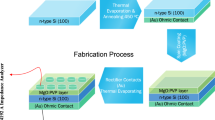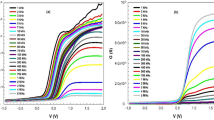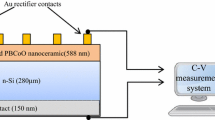Abstract
The frequency and voltage dependence of complex dielectric constant \(\left({\epsilon }^{*}\right)\), electric modulus \({(M}^{*})\), tangent loss \(\left(\text{t}\text{a}\text{n}\delta \right)\), ac electrical conductivity \(\left({\sigma }_{ac}\right)\), and impedance \(\left({Z}^{*}\right)\) of the Au/(Carbon Nanosheet-PVP composite)/n-Si capacitors was investigated using the impedance spectroscopy (IS) method in wide frequency range (1 kHz–5 MHz). \({\epsilon }^{{\prime }}-V\) plot yielded two distinct peaks located at 1.0 and 2.5 V in the low-frequency region. As the value of \({M}^{{\prime }}\) increases with increasing frequency, \({M}^{{\prime }{\prime }}\) shows a peak whose position shifts toward positive voltages with increasing frequency. Such response of these parameters to frequency can be attributed to the interfacial polarization and a special distribution of interface states at Au/interlayer interface since the dipoles and interface states both have enough time to follow the ac signal easily, thus the dipoles rotate around themselves and align with the field. The plot of \(\text{ln}\left({\sigma }_{ac}\right)-\text{l}\text{n}\left(\omega \right)\) has three linear regions corresponding to low, intermediate, and high frequencies, each yielding a different slope value thus indicating a different conduction mechanism for each frequency range. It was found that the obtained value of \({\epsilon }^{{\prime }}\) is approximately five times higher than the bulk SiO2 at 1 kHz. The dielectric characterization reveals that the presence of the (Carbon Nanosheet-PVP composite) interlayer affects the electrophysical features of the fabricated device. In other words, the utilization of the abovementioned interlayer is showing a considerable improvement in the performance of the MS structure with respect to high-energy storage capacity. The use of the Carbon Nanosheet-PVP composite as an interfacial layer instead of conventional insulators has improved device performance over a wide range of frequencies and voltages.










Similar content being viewed by others
References
Z.-M. Dang, J.-K. Yuan, S.-H. Yao, R.-J. Liao, Flexible nanodielectric materials with high permittivity for power energy storage. Adv. Mater. 25, 6334–6365 (2013)
M. Sadiq, M.M. Hasan Raza, A.K. Singh, S.K. Chaurasia, M. Zulfequar, A. Arya, J. Ali, Dielectric properties and ac conductivity behavior of rGO incorporated PVP-PVA blended polymer nanocomposites films. Mater. Today Proc. 49, 3164–3169 (2022)
V.R. Reddy, S.K. Upadhyaya, A. Gupta, A.M. Awasthi, S. Hussain, Enhanced dielectric and ferroelectric properties of BaTiO3 ceramics prepared by microwave assisted radiant hybrid sintering. Ceram. Int. 40, 8333–8339 (2014)
T.N. Zhou, X.D. Qi, Q. Fu, The preparation of the poly(vinyl alcohol)/graphene nanocomposites with low percolation threshold and high electrical conductivity by using the large-area reduced graphene oxide sheets. Express Polym. Lett. 7, 747–755 (2013)
M. Sharma, S.K. Tripathi, Frequency and voltage dependence of admittance characteristics of Al/Al2O3/PVA:n-ZnSe Schottky barrier diodes. Mat. Sci. Semicon Proc. 41, 155–161 (2016)
Q. Liu, X. Zhu, Z. Huo, X. He, Y. Liang, M. Xu, Electrochemical detection of dopamine in the presence of ascorbic acid using PVP/graphene modified electrodes. Talanta 97, 557–562 (2012)
C. Bilkan, Y. Azizian-Kalandaragh, S. Altindal, R. Shokrani-Havigh, Frequency and voltage dependence dielectric properties, ac electrical conductivity and electric modulus profiles in Al/Co3O4-PVA/p-Si structures. Phys. B 500, 154–160 (2016)
S.M. Zhang, L. Lin, H. Deng, X. Gao, E. Bilotti, T. Peijs, Q. Zhang, Q. Fu, Synergistic effect in conductive networks constructed with carbon nanofillers in different dimensions. Express Polym. Lett. 6, 159–168 (2012)
K.S. Novoselov, A.K. Geim, S.V. Morozov, D. Jiang, Y. Zhang, S.V. Dubonos, I.V. Grigorieva, A.A. Firsov, Electric field effect in atomically thin carbon films. Science 306, 666–669 (2004)
J.Z. Kovacs, B.S. Velagala, K. Schulte, W. Bauhofer, Two percolation thresholds in carbon nanotube epoxy composites. Compos. Sci. Technol 67, 922–928 (2007)
G.C. Long, C.Y. Tang, K.W. Wong, C.Z. Man, M.K. Fan, W.M. Lau, T. Xu, B. Wang, Resolving the dilemma of gaining conductivity but losing environmental friendliness in producing polystyrene/graphene composites via optimizing the matrix-filler structure. Green. Chem. 15, 821–828 (2013)
O. Sevgili, On the examination of temperature-dependent possible current-conduction mechanisms of Au/(nanocarbon-PVP)/n-Si Schottky barrier diodes in wide range of voltage. J. Mater. Sci-Mater El 32, 10112–10122 (2021)
Q.G. He, J. Liu, J.X. Feng, Y.Y. Wu, Y.L. Tian, G.L. Li, D.C. Chen, Sensitive voltammetric sensor for tryptophan detection by using polyvinylpyrrolidone functionalized Graphene/GCE. Nanomaterials-Basel 10, 125 (2020)
C. Latha, K. Venkatachalam, Structural, vibrational, thermal, electrical properties of PVP-PVC blend NH4SCN. Polym. Bull. 74, 3123–3137 (2017)
S.K.S. Basha, G.S. Sundari, K.V. Kumar, M.C. Rao, Optical and dielectric properties of PVP based composite polymer electrolyte films. Polym. Sci. Ser. A 59, 554–565 (2017)
S.K.S. Basha, G.S. Sundari, K.V. Kumar, M.C. Rao, Structural and dielectric properties of PVP based composite polymer electrolyte thin films. J. Inorg. Organomet. P 27, 455–466 (2017)
O. Cicek, G. Koca, S. Altindal, High dielectric performance of heterojunction structures based on spin-coated graphene-PVP thin film on silicon with gold contacts for organic electronics. Ieee T Electron Dev 69, 304–310 (2022)
S. Demirezen, S.A. Yeriskin, Frequency and voltage-dependent dielectric spectroscopy characterization of Al/(Coumarin-PVA)/p-Si structures. J. Mater. Sci-Mater El 32, 25339–25349 (2021)
E.E. Tanrikulu, S.A. Yeriskin, On the changes in the dielectric, electric modulus, and ac electrical-conductivity in the Al/(C(29)H(32)O17)/p-Si (MPS) structures in wide range of frequency and voltage. Phys. B 623, 413345 (2021)
D.E. Yildiz, A. Kocyigit, M.O. Erdal, M. Yildirim, Dielectric characterization of Al/PCBM:ZnO/p-Si structures for wide-range frequency. B Mater. Sci. 44, 1–7 (2021)
S. Altindal, A. Barkhordari, Y. Azizian-Kalandaragh, B.S. Cevrimli, H.R. Mashayekhi, Dielectric properties and negative-capacitance/dielectric in Au/n-Si structures with PVC and (PVC:Sm2O3) interlayer. Mat. Sci. Semicon. Proc. 147, 106754 (2022)
A. Buyukbas-Ulusan, S.A. Yeriskin, A. Tataroglu, M. Balbasi, Y. Azizian-Kalandaragh, Dielectric, ac conductivity and electric modulus studies at MPS structure with (Cu2O-CuO)-doped PVA interfacial layer. Optoelectron. Adv. Mat. 14, 256–260 (2020)
M.M. Bulbul, Frequency and temperature dependent dielectric properties of Al/Si3N4/p-Si(100) MIS structure. Microelectron. Eng. 84, 124–128 (2007)
E.H. Nicollian, J.R. Brews, MOS (Metal Oxide Semiconductor) Physics and Technology, Wiley Classics Library ed ed (Wiley-Interscience, Hoboken, N.J, 2003)
A. Chełkowski, Dielectric Physics (Elsevier Scientific, Amsterdam, Oxford, 1980)
S. Demirezen, H.G. Cetinkaya, S. Altindal, Doping rate Interface states and polarization effects on dielectric properties, electric modulus, and AC conductivity in PCBM/NiO:ZnO/p-Si structures in wide frequency range. Silicon-Neth (2022). https://doi.org/10.1007/s12633-021-01640-0
A.M. Akbas, A. Tataroglu, S. Altindal, Y. Azizian-Kalandaragh, Frequency dependence of the dielectric properties of Au/(NG:PVP)/n-Si structures. J. Mater. Sci-Mater El 32, 7657–7670 (2021)
S. Altindal, M. Ulusoy, S. Ozcelik, Y. Azizian-Kalandaragh, On the frequency-dependent complex-dielectric, complex-electric modulus and conductivity in Au/(NiS:PVP)/n-Si structures. J. Mater. Sci-Mater El 32, 20071–20081 (2021)
O. Sevgili, Y. Azizian-Kalandaragh, S. Altindal, Frequency and voltage dependence of electrical and dielectric properties in metal-interfacial layer-semiconductor (MIS) type structures. Phys. B 587, 412122 (2020)
H.N. Chandrakala, B. Ramaraj, G.M. Shivakumaraiah, Madhu, Siddaramaiah, The influence of zinc oxide-cerium oxide nanoparticles on the structural characteristics and electrical properties of polyvinyl alcohol films. J. Mater. Sci. 47, 8076–8084 (2012)
E.H. Nicollian, J.R. Brews, J.R. Brews, MOS (Metal Oxide Semiconductor) Physics and Technology (Wiley, New York, 1982)
Y. Safak-Asar, T. Asar, S. Altindal, S. Ozcelik, Investigation of dielectric relaxation and ac electrical conductivity using impedance spectroscopy method in (AuZn)/TiO2/p-GaAs(110) schottky barrier diodes. J. Alloy Compd. 628, 442–449 (2015)
Y. Badali, S. Altindal, I. Uslu, Dielectric properties, electrical modulus and current transport mechanisms of Au/ZnO/n-Si structures. Prog Nat. Sci-Mater 28, 325–331 (2018)
I. Tascioglu, O. Sevgili, Y. Azizian-Kalandaragh, S. Altindal, Frequency-dependent admittance analysis of Au/n-Si structure with CoSO4-PVP interfacial layer. J. Electron. Mater. 49, 3720–3727 (2020)
G.A. Kontos, A.L. Soulintzis, P.K. Karahaliou, G.C. Psarras, S.N. Georga, C.A. Krontiras, M.N. Pisanias, Electrical relaxation dynamics in TiO2 - polymer matrix composites. Express Polym. Lett. 1, 781–789 (2007)
A. Kaya, S. Alialy, S. Demirezen, M. Balbasi, S.A. Yeriskin, A. Aytimur, The investigation of dielectric properties and ac conductivity of Au/GO-doped PrBaCoO nanoceramic/n-Si capacitors using impedance spectroscopy method. Ceram. Int. 42, 3322–3329 (2016)
Y.S. Asar, T. Asar, S. Altindal, S. Ozcelik, Dielectric spectroscopy studies and ac electrical conductivity on (AuZn)/TiO2/p-GaAs(110) MIS structures. Philos. Mag 95, 2885–2898 (2015)
F. Moura, E.C. Aguiar, E. Longo, J.A. Varela, A.Z. Simoes, Dielectric properties of soft chemical method derived CaCu3Ti4O12 thin films onto Pt/TiO2/Si(100) substrates. J. Alloy Compd. 509, 3817–3821 (2011)
E. Locorotondo, L. Pugi, L. Berzi, M. Pierini, S. Scavuzzo, A. Ferraris, A.G. Airale, M. Carello, Modeling and simulation of constant phase element for battery electrochemical impedance spectroscopy. IEEE 5th Int. Forum Res Technol Soc Ind (RTSI) (2019). https://doi.org/10.1109/RTSI.2019.8895597
N. Borwornpornmetee, R. Chaleawpong, P. Charoenyuenyao, A. Nopparuchikun, B. Paosawatyanyong, P. Sittimart, T. Yoshitake, N. Promros, Reverse bias dependent impedance and dielectric properties of Al/n-NC FeSi2/p-Si/Pd heterostructures formed by facing-targets sputtering. Mat. Sci. Semicon Proc. 146, 106641 (2022)
Acknowledgements
The authors would like to thank Gazi University Academic Writing Application and Research Center for proofreading the article.
Author information
Authors and Affiliations
Contributions
The manuscript was written with the contributions of all authors. All authors have approved the final version of the manuscript. YŞA contributed to investigation, calculations, and writing, reviewing, & editing of the manuscript, ÖS contributed to measurements and reviewing & editing of the manuscript. ŞA contributed to review & editing of the manuscript and supervising.
Corresponding author
Ethics declarations
Conflict of interest
There are no conflicts to declare.
Research data policy and data availability statements
The datasets generated and/or analyzed during the current study are available from the corresponding author on reasonable request.
Additional information
Publisher’s Note
Springer Nature remains neutral with regard to jurisdictional claims in published maps and institutional affiliations.
Rights and permissions
Springer Nature or its licensor (e.g. a society or other partner) holds exclusive rights to this article under a publishing agreement with the author(s) or other rightsholder(s); author self-archiving of the accepted manuscript version of this article is solely governed by the terms of such publishing agreement and applicable law.
About this article
Cite this article
Şafak Asar, Y., Sevgili, Ö. & Altındal, Ş. Investigation of dielectric relaxation and ac conductivity in Au/(carbon nanosheet-PVP composite)/n-Si capacitors using impedance measurements. J Mater Sci: Mater Electron 34, 893 (2023). https://doi.org/10.1007/s10854-023-10320-1
Received:
Accepted:
Published:
DOI: https://doi.org/10.1007/s10854-023-10320-1




